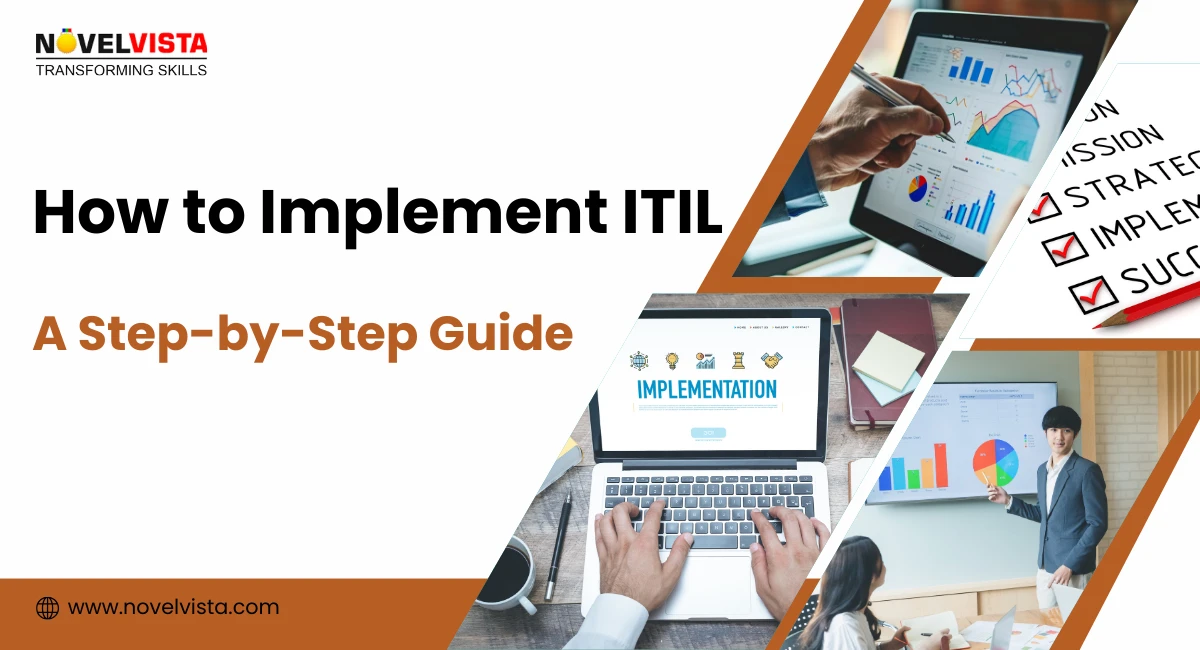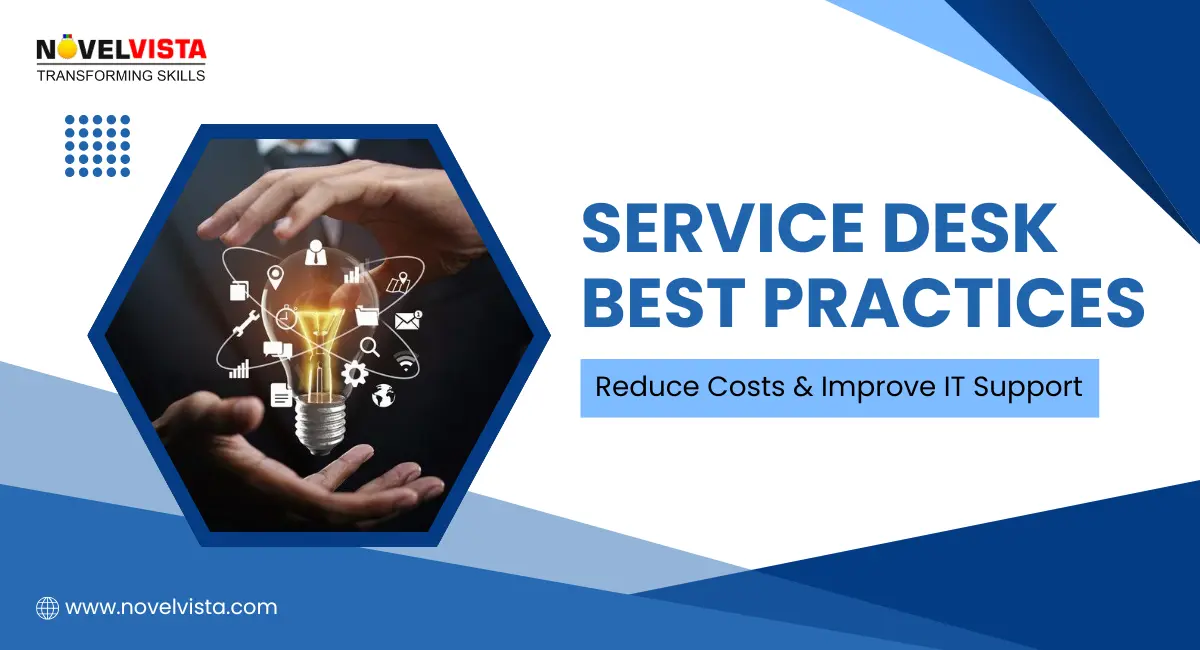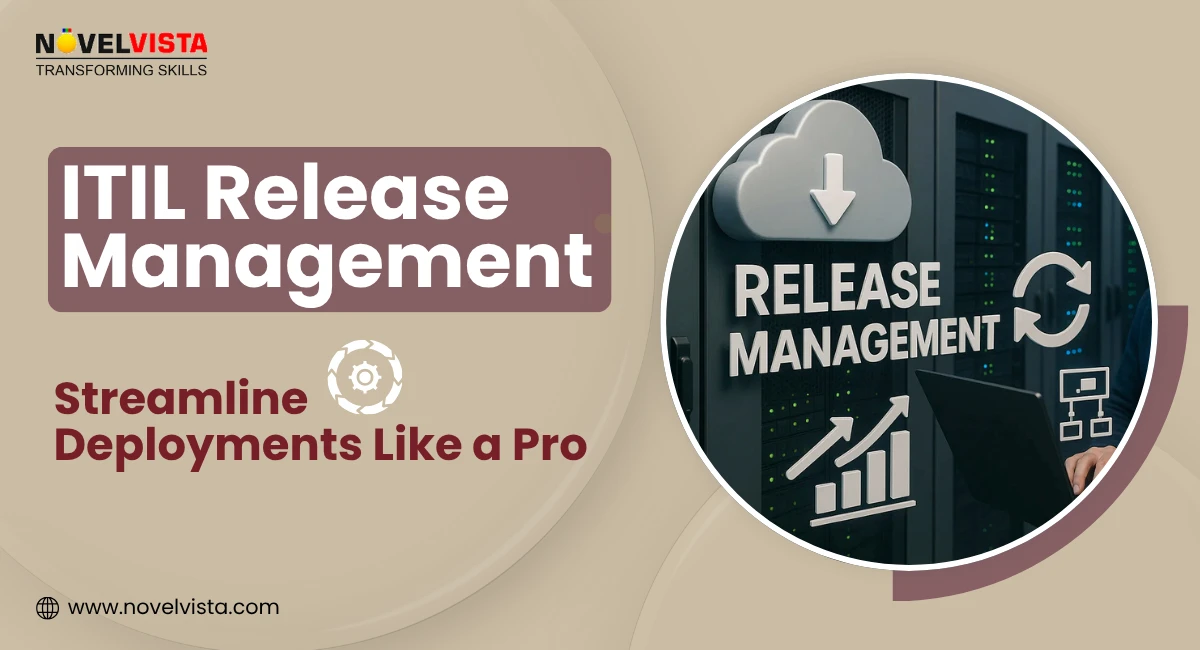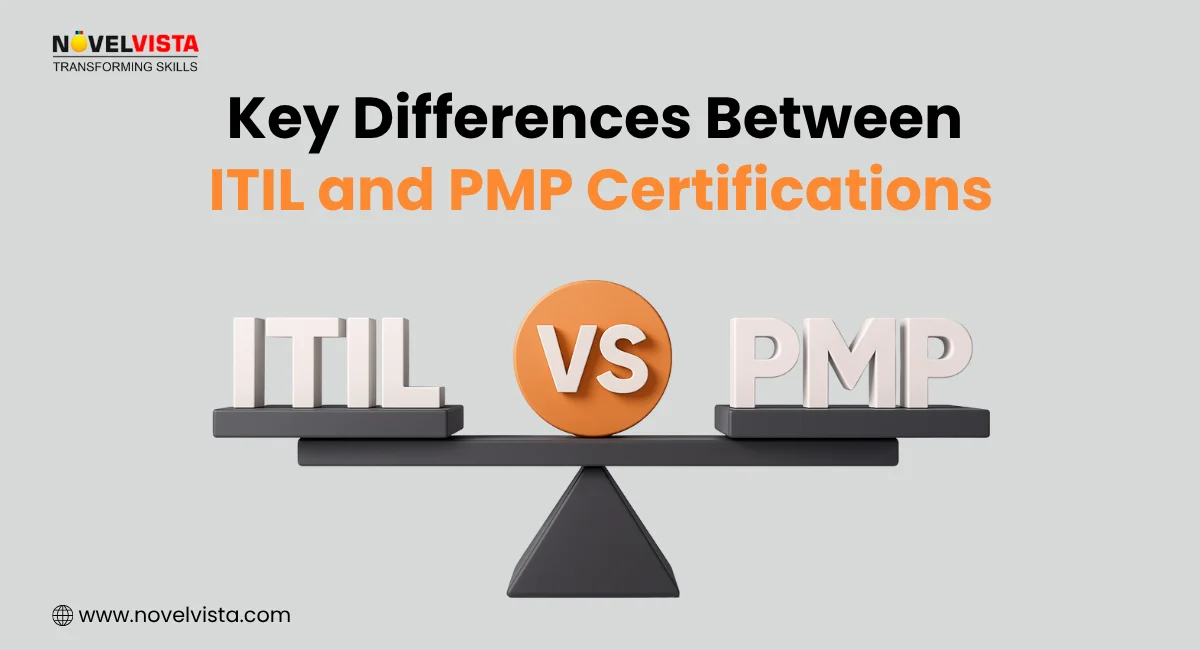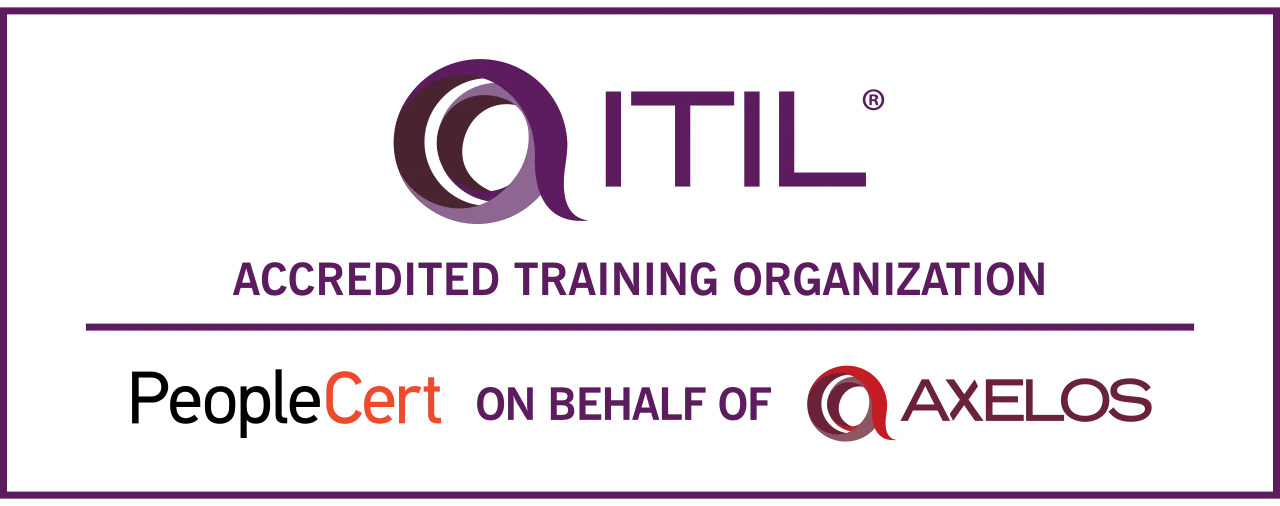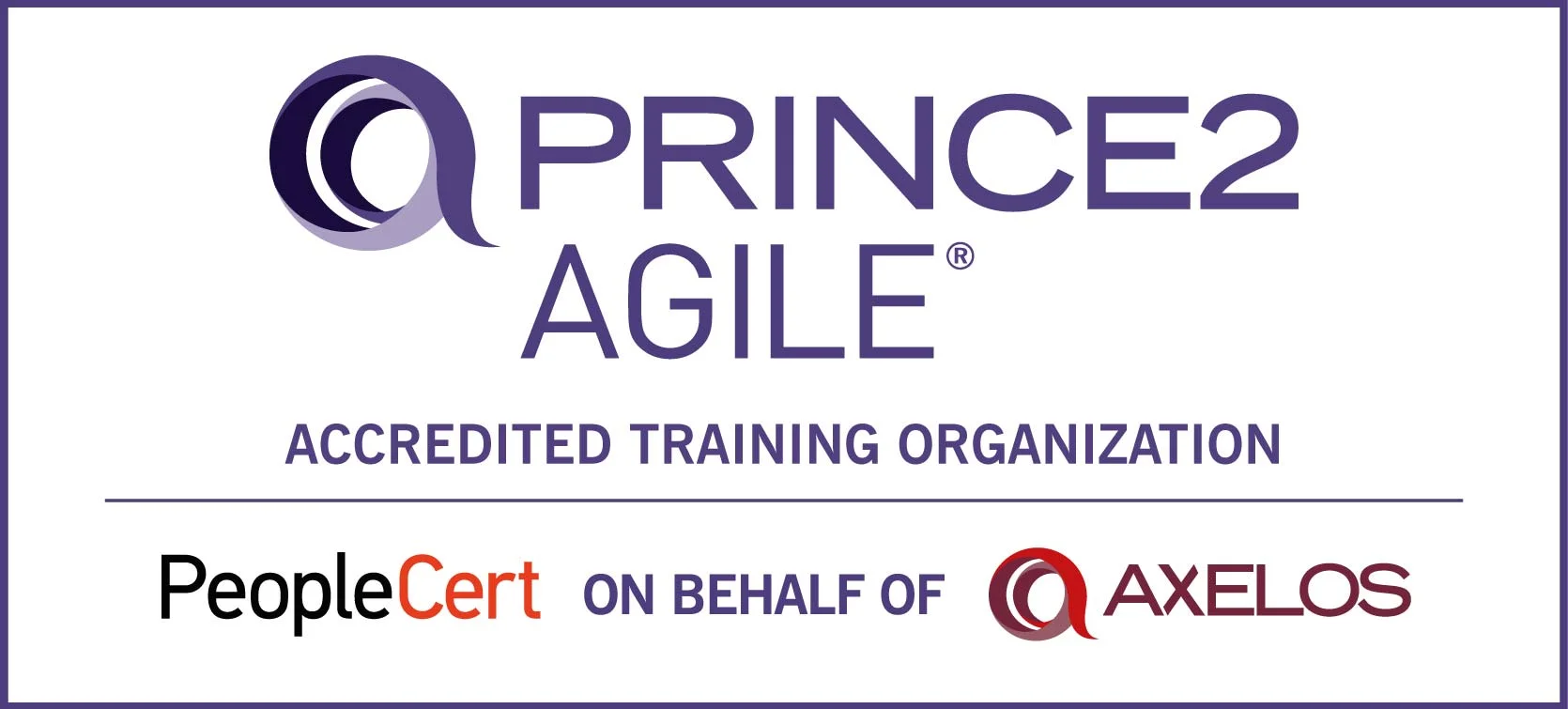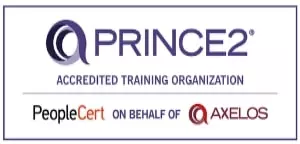- What is ITIL 4?
- How to Implement ITIL in 7 Easy Steps:
- Understanding the ITIL Framework
- ITIL Best Practices for Seamless Implementation
- ITIL Implementation Roadmap: Step-by-Step Guide
- Common Challenges in ITIL Implementation and How to Overcome Them
- Case Studies: Real-World ITIL Success Stories
- The Future of ITIL: Trends & Innovations
- Conclusion
How to implement ITIL and revolutionize your IT operations? It’s more than just adopting a framework; it’s about transforming your organization’s approach to IT service management. By following a clear, structured implementation plan, you can enhance efficiency, reduce downtime, and align IT with broader business objectives. Let's go through a proven roadmap to achieve seamless ITIL adoption, ensuring your team is equipped for success. Ready to optimize your IT services? Let’s dive in!
What is ITIL 4?
ITIL 4 is the latest evolution of the Information Technology Infrastructure Library (ITIL), a globally recognized framework for managing IT services. It focuses on aligning IT services with business needs, enhancing agility, and fostering a culture of continuous improvement. ITIL 4 incorporates modern technologies, agile methodologies, and DevOps principles, offering a comprehensive approach to service management that supports digital transformation and value creation.
For a deeper dive into ITIL 4, its key components, and how it can help your organization, explore our detailed ITIL 4 Guide
How to Implement ITIL in 7 Easy Steps:
1. Building Capability, Understand ITIL and go for Foundation Certification:
If you want to implement ITIL methodology in your organization or become a ITIL implementer in your current organization then first you have to understand the ITIL methodology or process and its concepts, best practices. It is always recommended to attend ITIL foundation training than only certification. As in training lot of practical examples are covered along with theory.
Training is usually delivered by industry expert trainers who have more than 20 – 25 years of experience under their belt, and they share best practices, actual case studies, real life example
2. Do a Gap analysis and Identify the quick wins (Remember 80:20 rule)
The basics of Gap analysis are the doing comparison between the actual performance and the potential or desired performance and if the actual performance is lower than desired performance cause has to be identified e.g investment, manpower, technology investment.
Pareto analysis technique is very effective here. The 80:20 rule states that 20 percent of the inputs or activities are responsible for 80 percent of the outcomes or results. By doing gap analysis and applying 80:20 rule you can find the root cause to your low performance and find fix to solve these issues.
3. Get Buy in from the management and design or tailor the processes:
A management buy is about agreeing to support something or accepting a decision(to Tailor the process) or action as something you could be a part of.
Process Tailoring:
“One Size Fits All” doesn’t always fit
As best practices for one might not be best for another, thus they have to be tailored whenever you want to implement them in different environment (organizations)
Triggers for Tailoring:
- Organizations Experience
- Environment
- Industry being catered to
- The Kind of Service/Process being delivered
The following are some typical examples of process tailoring:
- Adding/removing Process activities and tasks
- Changing milestones, and outputs that would be made available at each milestone
- Responsibilities for review and approval (a RACI table is often useful)
- Detailed procedures for reporting progress, performing measurements, managing requirements, managing change requests, etc.
4. Spread awareness and communicate the change:
If you are changing/tailoring the processes or adding modifying the process then Communication plays important role. Communication would be used for creating user awareness for the changes enabling wide use and acceptance of the updated/tailored processes.
5. Implement and monitor the change:
If all the procedure mentioned above performs accurately then you have to implement the changes and monitor the performance but while monitoring you have to concentrate on the new changes you have made. Because this might be your performance enhancer or performance degrader.
6. Optimization and Improvements
After successfully achieving the desired performance Constant monitoring of process and outcome is required for to finding new improvement opportunities As Sky is the Limit.
7. Deliver Value for customer delight
By optimizing resources and processes to deliver the right product or right service to the customer by delivering Best in class solutions to provide value for customer’s investment
Remember, ITIL implementation is not a one-time activity but an ongoing journey of continual improvement. It requires commitment, dedication, and collaboration from all levels of the organization to achieve the desired outcomes and maximize the benefits of ITIL.
Understanding the ITIL Framework
Understanding what ITIL is and why it matters before diving into how to implement ITIL is crucial.
The ITIL framework is a collection of globally respected IT service management and best practices. ITIL focuses on ensuring service quality, meeting business needs, and enhancing IT efficiency.
Why Should You Implement ITIL?
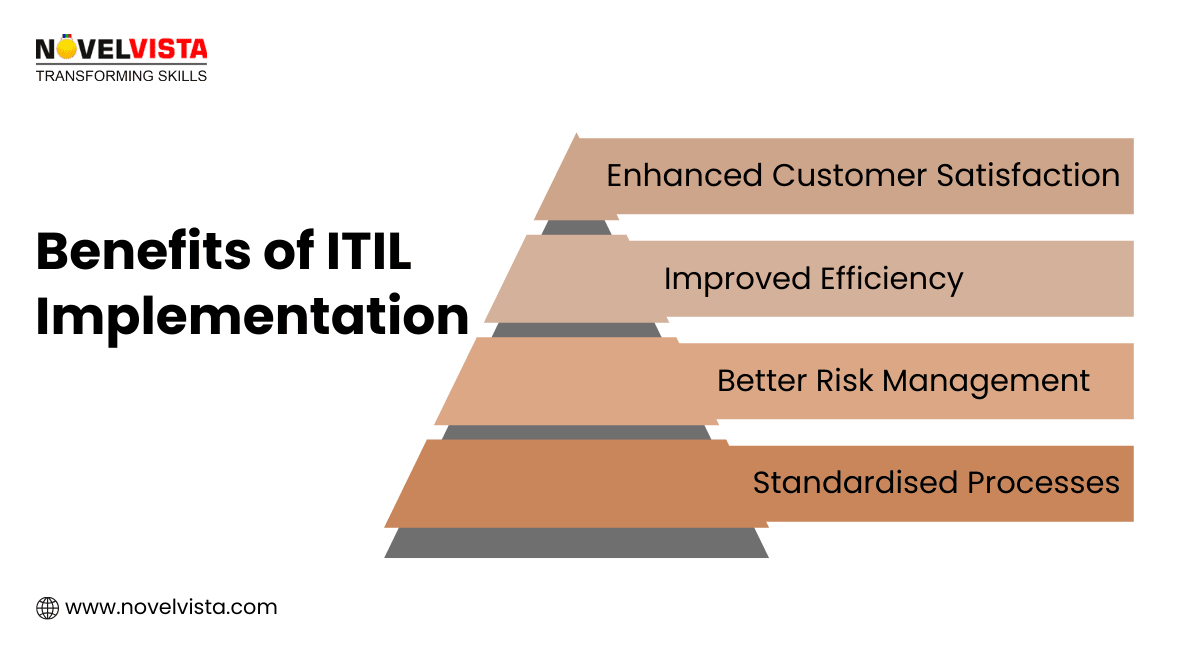
- Improved Efficiency: Optimized process minimize wasting resources and time.
- Standardised Processes: ITIL creates consistent service management practices.
- Better Risk Management: ITIL reduces service disruption and security threats.
- Enhanced Customer Satisfaction – Better service delivery and faster response times.
Want to gain a solid foundation in ITIL? Enrolling in the ITIL 4 Foundation Certification Training Course would be the best decision!
Check out: Benefits of ITIL 4 implementation
ITIL Best Practices for Seamless Implementation
Following ITIL practices ensures smooth adaptation and lasting progress. Here’s what organisations should focus on:
- Embrace a Progressive Approach: Implement ITIL in small, manageable sections to prevent overwhelming teams.
- Engage Stakeholders Early: Collaboration between leadership, IT, and end-users enhances ITIL adoption.
- Use ITSM Tools: Automate workflows and improve tracking with ITIL-compliant tools.
- Provide ITIL Training: Enhance employee capabilities to ensure they understand and apply best practices effectively.
- Monitor and Improve Continuously: ITIL continuous improvement ensures long-term success.
Download: ITIL 4 Core Concepts Cheat Sheet
Quickly grasp ITIL 4 fundamentals. A perfect guide for aspiring professionals preparing for ITIL Foundation certification success.
ITIL Implementation Roadmap: Step-by-Step Guide
A systematicITIL implementation roadmap ensures the successful and seamless adoption of ITIL best practices.
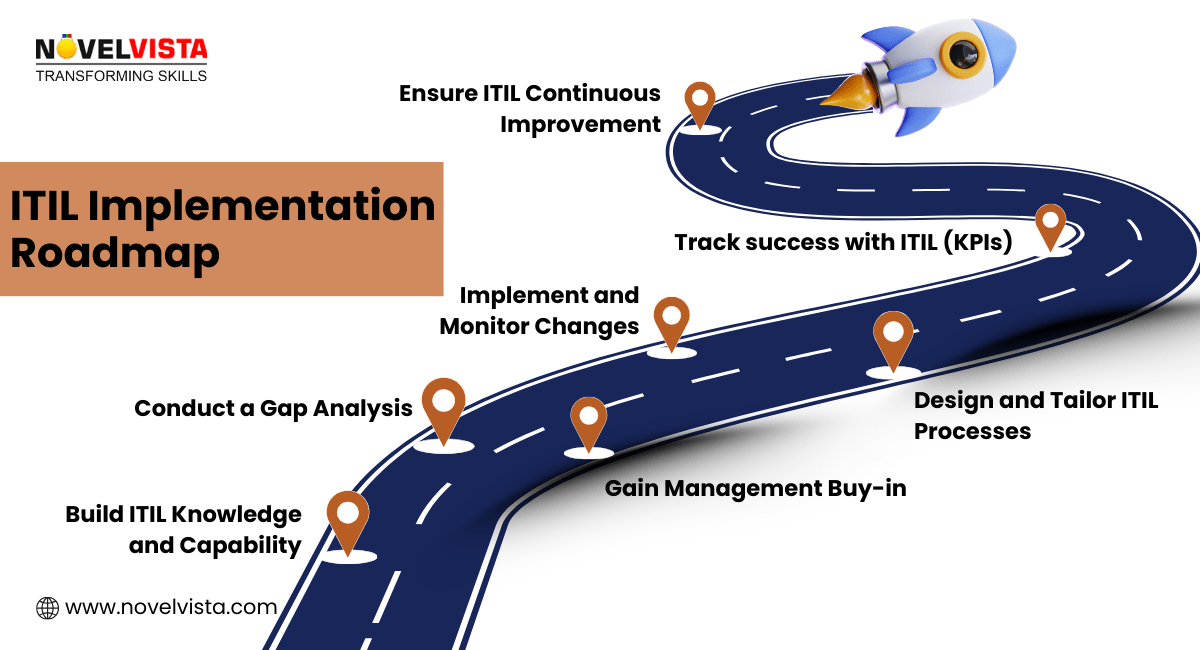
STEP 1: Build ITIL Knowledge and Capability.
Start the process by understanding its core methodologies and principles. ITIL training and certification help IT professionals learn about ITIL roles and responsibilities, ITIL continuous improvementstrategies, and IT service management.
STEP 2: Conduct a Gap Analysis.
Evaluate your current ITSM practices and compare them with ITIL's best practices. Identify potholes in tools, processes, or team skills to create a well-defined plan for improvements.
STEP 3: Gain Management Buy-in.
Getting the support of your leadership team is a must for a successfulITIL framework implementation. Explain the benefits of ITIL to them, such as cost efficiency, risk reduction, and improved service performance.
STEP 4: Design and Tailor ITIL Processes.
Not every ITIL process is one-size-fits-all. Customise the process to fit your organisation’s distinct needs structure and needs. Tailor it to what will work best for your team.
STEP 5: Implement and Monitor Changes.
Gradually carry out ITIL processes and tools with proper monitoring. Focus onITIL Change Management to reduce risks caused by new implementations.
STEP 6: Track success with ITIL Key Performance Indicators (KPIs).
Using ITIL Key Performance Indicators (KPIs) helps evaluate ITIL’s impact. Key metrics include:
- Incident Response Time.
- Change Success Rates.
- Service Availability Levels.
STEP 7: Ensure ITIL Continuous Improvement.
ITIL isn’t a one-off project—it’s an ongoing journey. ITIL's continuous improvement involves regularly evaluating performance and refining processes.
Common Challenges in ITIL Implementation and How to Overcome Them
1. Challenge: Resistance to change.
- Solution: Show your team how ITIL will make their jobs easier and give them a heads-up with training.
2. Challenge: Lack of clear objectives.
- Solution: Develop a clearITIL implementation roadmap to ensure an organised launch.
3. Challenge: Complex IT Environment.
- Solution: Tailor ITIL framework implementation to align with the existing infrastructure.
Case Studies: Real-World ITIL Success Stories
Case Study 1: ITIL in Healthcare
A hospital implemented ITIL best practices to improve IT support and patient record access. Results?
- 50% faster IT response times.
- Significant reduction in system downtime.
Case Study 2: ITIL in Banking
A financial institution introduced ITIL change management to enhance service reliability. Outcomes?
- 40% faster incident resolution.
- Stronger security and compliance.
These success stories show that effective ITIL implementation delivers satisfiable business benefits.
The Future of ITIL: Trends & Innovations
- AI and Automation in ITSM: AI-driven analytics and automated ITSM tools improve service efficiency.
- Cloud-Based ITIL Frameworks: Organizations are Embracing cloud-based ITIL for improved scalability.
- Agile & DevOps Integration: ITIL is evolving to support faster, iterative IT service delivery models.
Keeping up with ITIL trends ensures organisations stay competitive and continuously improve IT services.
Conclusion
Understanding how to implement ITIL is the first step in transforming IT service management. Organizations that follow a well-definedITIL implementation roadmap and leverage ITIL best practices see higher efficiency, reduced downtime, and improved customer satisfaction.
Ready to start your ITIL journey? Get certified with the ITIL 4 Foundation Certification Training Course today with NovelVista!
Frequently Asked Questions
- Service Strategy – Define IT service goals aligned with business needs.
- Service Design – Plan and design new or modified services.
- Service Transition – Build, test, and deploy services.
- Service Operation – Manage daily IT service delivery.
- Continual Service Improvement – Monitor, analyze, and enhance services.
Author Details

Mr.Vikas Sharma
Principal Consultant
I am an Accredited ITIL, ITIL 4, ITIL 4 DITS, ITIL® 4 Strategic Leader, Certified SAFe Practice Consultant , SIAM Professional, PRINCE2 AGILE, Six Sigma Black Belt Trainer with more than 20 years of Industry experience. Working as SIAM consultant managing end-to-end accountability for the performance and delivery of IT services to the users and coordinating delivery, integration, and interoperability across multiple services and suppliers. Trained more than 10000+ participants under various ITSM, Agile & Project Management frameworks like ITIL, SAFe, SIAM, VeriSM, and PRINCE2, Scrum, DevOps, Cloud, etc.
Course Related To This blog
ITIL4 Specialist Monitor Support and Fulfil Certification
ITIL 4 Specialist Sustainability in Digital & IT
ITIL® 4 Strategic Leader Digital And IT Strategy (DITS)
ITIL® 4 Specialist Drive Stakeholder Value
ITIL® 4 Specialist High Velocity IT
ITIL® 4 Strategist Direct, Plan & Improve
ITIL® 4 Specialist Create Deliver & Support
ITIL® 4 Foundation Certification
Confused About Certification?
Get Free Consultation Call

